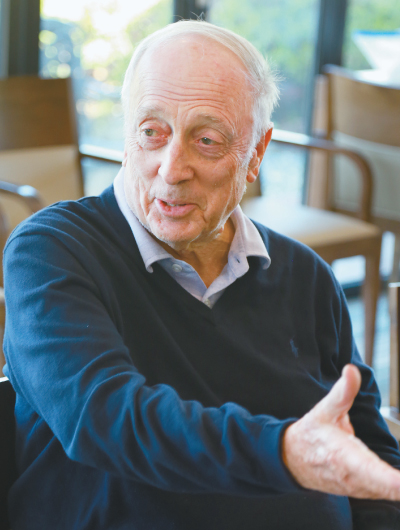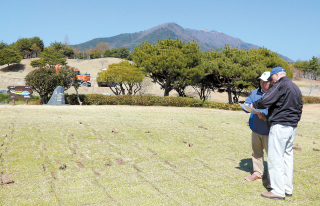Meet the man behind Korea’s new LPGA course

Rees Jones speaks during an interview at Asiad Country Club in Busan on April 4. [LPGA]
Having redesigned multiple championship courses, Jones has earned his reputation as one of the best golf course architects in the industry, nicknamed the “The Open Doctor” because seven courses he has worked on have hosted the U.S. Open.

Rees Jones, right, and Bryce Swanson inspect the course renovation at the Asiad Country Club on April 4. [LPGA]
After an undergrad at Yale and graduate studies at Harvard, Jones started his career at his father’s firm, Robert Trent Jones Inc. Then, in 1974, after 10 years working under his father, Rees Jones established his own company, Rees Jones Inc.
Robert Trent Jones Sr. designed his courses with a philosophy of easy bogeys and hard pars. Yet the younger Jones takes a different approach, focusing more on creating courses that are fair, challenging, continually interesting to play and visually exciting.
Although he designed multiple championship courses, Rees Jones likes to focus first on the average player. Whether designing or redesigning a course, Rees thinks of the weekend players first and the pros that might turn out for huge tournaments second.
Having designed or redesigned over 225 golf courses throughout his career, Jones has accepted his first job in Korea, to renovate the Asiad Country Club. The LPGA Tour players will visit the course for the first time in October this year to compete at the inaugural LPGA International Busan, hosted by BMW Group Korea.
Jones, along with Bryce Swanson, vice president and the senior designer at Rees Jones Inc., sat down for an interview with the Korea JoongAng Daily at the Asiad club in Busan on April 4.
Below are edited excerpts of the interview.
Q. How will the Asiad Country Club course change after these renovations?
A. It’ll be different. It isn’t like [the players] played the tournament last year and now we’re doing it over and they’re playing. So they’re not going to know totally what we did. They’re going to like it a lot more because we’ve taken a lot of penalty areas out that were overpenalizing.
We’ve really tucked some bunkers in places that’s going to make them think, which means they’ll try to get it next to the pin or go for the green. I think they’re going to like it because it’s going to be strategic and it’s got a lot of room off the tee, which means they can take out their driver. That’s important to men and women.
The greens […] can change on any given day. The first year, they’ll learn it. Next year, they’ll know it better. They’ll love this golf course.
What’s good about this site?
First of all, it’s the people. The most important aspect of our profession is having really good people to work with because we’re a team. The owner, the LPGA and ourselves, we’re all a team. And I think that’s what’s so attractive about this job: everybody’s working well together and shapers are working well together and contractors are good - we’re going to achieve our goal.
I always follow the people and then the site - I’ve been very fortunate to get great sites. But I think on this site - I think the vegetation is good, the typography is very different. It’s quite natural so you don’t have to overshape things. This golf course is perfectly suited.
When you first looked around, were there any other courses that came to mind?
Maybe Baltusrol [Golf Club in Springfield, New Jersey]. It’s got a flow to it like Baltusrol. I think Bellerive [Country Club in Town and Country, Missouri] too.
We were very excited when we first saw it and we really saw that we can do what Asiad wanted done to make it more special. That’s the ideal job for a golf course architect.
We’re very proud of the fact that when you go to our golf courses, you don’t know it’s a Rees Jones golf course. A lot of architects over the years have had a design style that [means] you know exactly who it is. We really adapt to the site and don’t want to have a specific design style. I think you can see that in all of our championship golf courses. [And if] they have to ask you who designed it, I think that’s a compliment.
Once the renovation is done, is this going to be a brand new course?
To everyday golfers, it’ll feel like a brand new course - but it’s not: it’s going to have a whole different personality, that’s why.
Which hole’s going to be the signature hole?
I don’t like signature holes because I don’t want one hole to be thought to be better than the others. I want each foursome to go out and each one of them has a favorite hole, not the same one.
This is going to be the golf course that people travel a long way to play. If I’ve accomplished that, I’ve accomplished my goal.
You’ve worked on a lot of courses around the world. Would you say there’s a difference in the characteristics of courses in North American versus Asia?
I think Asian golf courses are somewhat similar to American golf courses. I love the fact that they still have trees in play - I like that about Japan and I like that about Korea. I really think the trees are very important, environmentally and nature wise. Just having a good feeling of why you’re there.
Like, you see Bubba Watson cutting a wedge during the Masters. If it’s wide open, there are no trees, then you have to go to the rough to create the chance and all [you have to do] is hack out. So I think that’s why I like the Asian courses. Even trees on the fairway, I think that’s great.
Are there any challenges that you face when designing or renovating golf courses in a country that has a monsoon season like Korea?
Well, we get those in the United States too. I think we get worried about the trees. This is high ground. It’s not like Ocean Forest [Golf Club in Sea Island, Georgia], which is right by the ocean. When hurricanes come up the east coast, we worry. I think this course can handle any storm because the ground is so high.
You’re better known as a renovator than a designer. Do you agree with this?
My fame has come from championship renovations. They call me the “Open Doctor.” I didn’t have a nickname when I was a kid so now I have one, and that’s OK.
We’ve done some really fantastic golf courses that just don’t get the notoriety because championships aren’t played on them, except for the Walker Cup, [which] was played on Ocean Forest, which is one of my original courses. Like East Lake [Golf Club in Atlanta, Georgia], it’s a brand new golf course. Bellerive’s a brand new golf course. Torrey Pines [Golf Course in San Diego, California] is a brand new golf course. Congressional [Country Club in Bethesda, Maryland] is a brand new golf course.
Basically, I’m building brand new golf courses but I don’t get credit for that because they call it renovation. But they really are new golf courses.
How many of the courses that you renovated or designed have hosted major tournaments?
Six Ryder Cup Championships, nine PGA Championships, seven U.S. Opens, one Presidents Cup, two Walker Cups and the Tour Championship Course is also at our golf course, East Lake.
But I don’t know if I can break it down because some of them, some of the PGA courses and U.S. Open courses, are the same courses. This year we’re having the PGA at Bethpage Black [Course in Long Island, New York] and the Ryder Cup goes there in 2024. So it sounds like more courses.
Is there a difference when designing a PGA Tour course and an LPGA Tour course?
When we design any golf course, we’re really designing it for the everyday player. We’re doing the rework for everybody who plays there 365 days a year. Then we adapt it to a PGA, LPGA or championship golf course. But we don’t work from the championship down: we work from the everyday up.
Like Lake Merced [Golf Club] outside of San Francisco, where they played the Swinging Skirts tournament [and] the Mediheal [Championship], that’s like one of the women’s favorite golf courses. So I go to that tournament and I learn how they set it up and how they play it. So I’m ready for the next course.
My father taught me that: When I was a kid, at Baltusrol, he had me measure his drives in 1954 so I’d know where all the balls would go - I was just a kid, and he didn’t pay me.
Your brother has your father’s name, Trent Jones Jr. Growing up and taking up the same career, do you think that gave you a disadvantage?
You know too much. Yes, he had an advantage. I’ve been very fortunate in that I got the U.S. Open at [The Country Club in] Brookline, [Massachusetts]. I did that mainly through my personality. There were three other designers and that was my first U.S. Open and championship rebuild.
They asked me, “Why should we select you?”
I said, “Because I know the history of the country club and I know the history of the game.”
They said, “When can you start?”
I’ve dedicated myself to courses like Asiad and every job I’ve done. I didn’t take up too much work. And I got championship and championship and championship, over and over. I’m glad that I made my reputation with my own name.
I think I had a disadvantage, but now, later in life, I have the advantage.
At the Asiad course, how do you hope to challenge players?
The fifth hole - it’s tough - we’re trying to make it easier. This is the most famous hole on the golf course because it’s the hardest. We’re not making it easier for accomplished players. We’re just trying to make [it so that] the everyday player can get through that hole too.
BY KANG YOO-RIM [kang.yoorim@joongang.co.kr]










with the Korea JoongAng Daily
To write comments, please log in to one of the accounts.
Standards Board Policy (0/250자)